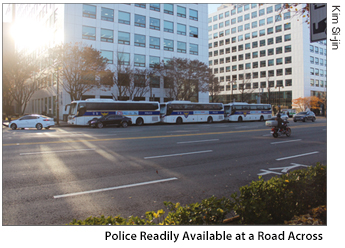
James Madison, one of the Founding Fathers of the United States of America, and the 4th president of the country he built, circumscribed modern democracy with division of power into three branches: the administration, the judiciary, and the legislature. The concept of such division of power was unprecedented, but validated itself all through history. By establishing the check-and-balance system between the three pillars that defined and ran free democracy, people enjoyed greater liberty unlike any other in the past millenniums and thrived. Now it is a norm for any country to exercise such system if it wants to prosper, and the Republic of Korea is no exception.
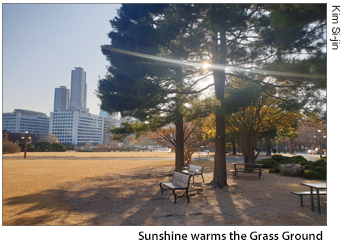
The Korean National Assembly (also known as “the National Assembly”) takes up the role of the legislature. It consists of 300 members, 225 chosen from direct votes of the people by assigned districts and 75 selected by proportional representation. Each congressman is to hire up to 6 secretaries to help his or her service to the people. The scale of the National Assembly is even greater when other administrative and non-administrative staffs are added. Having a history of more than 70 years, it has held 20 sessions so far. Its 21st session is now coming up with general election scheduled next April. With heavy pressure for the current incumbents to present their voters with some sort of political milestone before the next election, the National Assembly is now busy dealing with all the works that it has put off. This hectic atmosphere is multiplied by the preparations they have to make for the next run. No one can show the rush and impatience, though, for elitism and elegance are considered good virtues for politicians. Both rigor and silence pervade the National Assembly this winter.
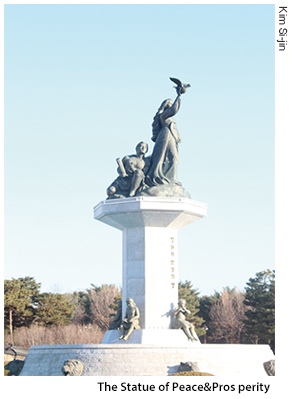
Probably because it has very much been depicted as a grail of arrogance and elitism, not many people know how accessible the Assembly is. During normal weekdays, any civilian including foreigners can freely enter the boundaries of the Assembly. Just take the subway line number 9 and stop at the National Assembly station. Beware that it is not an express stop though. When you come out of Exit 6, it directly leads to the entrance of the Assembly. Although one might get easily scared and warded off by the presence of the police officers, they do not chase off the visitors. The National Assembly is the gathering of people chosen by the people, so it is open to any person who sets his or her feet firmly in Korean soil.
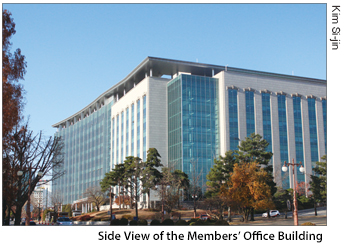
The beauty of the green scenery welcomes the visitors once upon making the entrance through the front gate. There is a spacious and well-designed park waiting to greet its people at the very center. Named as “the National Assembly Grass Ground,” it provides good stroll trails for people during their lunchtime. Also, at the center of the park is the statue called “the Statue of Peace and Prosperity” - which is surrounded by a fountain. Built in 1978, the Statue presents a graceful lady holding up a dove on a column, representing peace, and children playfully sitting below the columns in four directions, without a hint of worry.

On the left side of the Grass Ground, there is the Members’ Office Building. It is where the members of the Assembly have their offices and oversee most of their businesses. Along with the members’ offices are the branches of the main political parties such as the Democratic Party, the Korea Liberty Party, and many others. It is not open to the public unless there is an appointment made with the members or their respective secretaries. Nevertheless, once there is an open conference held by any of the members, civilians are more than welcome to visit and participate in the conference.
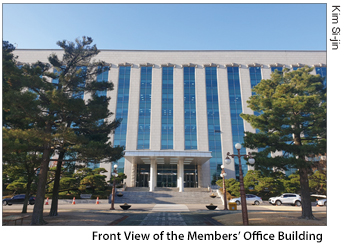
People should be reminded that the Assembly runs under the spirit of the serving the people. If there are any issues that one has to lodge, look up at the list of the committees in the Assembly and find out which one suits your interest. Confidently make contact with one of the members and request for a formal visit. Though it may not be so easily granted, one should bear in mind that such means of participation in politics are all due by every right and mandate upheld in the Constitution. It would be surprising to find out how the members and their staffs are readily at your service, to listen to the problem and respond with great formality and responsibility. One can even make a formal petition to make a statement at the press room at the 1st floor of the building, through the help of an incumbent. Everything can start from making a simple call.
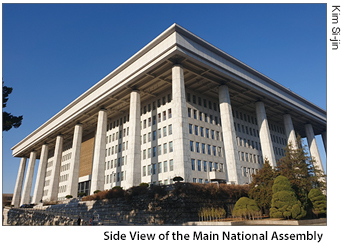
Going straight from the Grass Ground is none other than the main National Assembly Building. It catches the attention of the visitors very easily with its unique dome-shaped roof that has long been alleged to shelter a giant robot underneath. Unlike what most children would like to believe, it is where the general conference and votings on the policies are conducted. Although the meetings are not quite smoothly facilitated due to political reasons, it is the dead center of the Korean legislature, where concerns and interests of the people are reflected and processed. The main conference room has long been demeaned notoriously as a fighting ground in which actual fist fights went on in the previous decades. Nevertheless, as democracy ripened and awareness of the people grew, such physical collisions are much rarer to find and to be reported on the news on the spot. Visitors can freely tour in and out of the place upon the formal appointment, but it may not be allowed during the formal sessions.

On the right side of the Grass Ground is the National Assembly Library and the National Assembly Memorial Hall. The former is the second largest national library in Korea after the National Library of Korea; it is a storage of all the files and records of the Korean legislature. It is open to any person who is 18 of age and above, and teenagers are allowed to make a visit upon making appointments. One interesting thing about the Library is that its visitors cannot borrow files or documents but can only make copies for their references. Apart from up to 4 million books that tops on the shelves, it is the sacred bank of the history of modern Korea, keeping the stories and traces of how its legislative system has been performing and serving its people. The National Assembly Memorial Hall is a good tourist attraction. It sums up the history of the National Assembly with visible artefacts and documents. It is where the visitors’ course ends. A simple walk of about 10 to 15 minutes will brief the visitors on the last 70 years of path that the National Assembly has rolled on.

If one wants to take a tour at the National Assembly without much political intention, feel free to visit the official website of the National Assembly and arrange for a formal tour. It is open for an individual and even to a group up to the size of 50. The National Assembly is not far and distant. It does not have to appear only on television; everyone can make it as a part of their decisions and expressions of will. Of course, everyday life is too full of everything, and there may not be enough room to spare. It is the profession of politicians to run their jobs without having to make the people worry or participate directly in politics. It is one of the greater virtues for a country to practice indirect democracy. Nevertheless, changes for good can be made by caring just a little bit more and taking a step further. The Korean National Assembly; it is open to you for it is all yours.
Kim Si-jin
rlatlwls21c@uos.ac.kr

